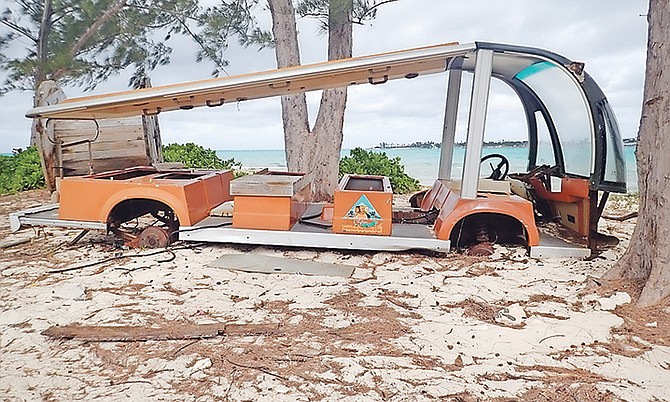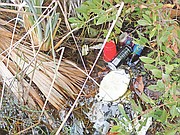By Athena Damianos
I wanted to weep.
Revisiting the Clifton Heritage Park on the western tip of New Providence was like a bad dream. Only it wasn’t a dream.
The garbage was real. The junk was real. The rutted ground from the four wheelers was real. So was the torn, rusted fencing.
What has happened to this 500-acre national park system?
It was a cool and windy Sunday and friends from Kentucky were in town. Too rough for the boat or swimming, we promised them a beautiful hike along a coast kissed by turquoise sea, plantation ruins and wetlands full of bird life.
What we found instead was a garbage dump.
Our first stop was the Clifton wetlands and we were thrilled to see they’d recovered nicely from the terrible salt damage caused by an earlier hurricane.
The wetlands were alive with birds - common marsh hens, American coots, ring billed duck, cormorants and snowy egrets.
Beneath the birds and tilapia fish, Styrofoam plates and cups, beer bottles and plastic littered the bottom of the pond.
Leaving the first beach at the canal to the sun worshippers, we passed an abandoned buggy with the name, Heritage National Park on the side, its wheels stripped.
We hiked along the bush trails, where the beautiful purple flowers of the morning glory vine tried in vain to cover the litter and debris.
Shrubbery sprouted from the historic plantation ruins, weakening the priceless hand cut limestone walls.
“What the heck is that doing here?” I pointed to an abandoned ice machine in the bush – the kind supermarkets and gas stations store bags of ice in.
I opened the aluminum door to peek inside.
“I wouldn’t do that,” my husband warned. “You never know what you’ll find inside.”
Too late - the door was open. Nothing but empty beer bottles inside.
I breathed a sigh of relief.
Our friends were incredulous. We were embarrassed.
Cutting through the bush to the coast, we hiked along the sun drenched shore line and listened to the sea. An osprey circled in flight overhead.
“There’s some good, some bad and some ugly,” our friend Rob, a geologist, commented.
Wooden picnic benches, painted in pretty pastels with the word “Clifton” cut out of the wood, rested haphazardly along the rocks, as if carried in by the tide. A couple of abandoned wooden shacks loomed in the background.
We came across a beach grill and bar, not far from a Clifton Heritage Authority sign prohibiting food and alcohol in the park. The cook and bartender, laid back and friendly, said they catered to Carnival cruise passengers.
Then the music started – not loud, thank goodness. But loud enough to drown the sound of nature.
A little further down the main road, a rusted gate and debris blocked the entrance to Antonius Roberts’ “Sacred Space”.
Here, slave figures carved from casuarina wood gaze tragically across the ocean in a symbolic display of a yearning to return to Africa. The sea murmurs below - haunting echoes of the past.
“Warning. Cliff diving is strictly prohibited,” the large red sign laying on its side on the ground declares. The miniature furniture carved from casuarina is gone, probably swept away by a hurricane.
Twisted and rusted fencing, a smashed garbage receptacle and piles of debris mark the entrance to the Sacred Space.
It is a million dollar view in a million dollar setting and it is a national disgrace.
The Clifton Heritage Authority blames the debris on Hurricane Matthew. The monster storm swept through the area 15 months ago .
CLIFTON REVISITED
The Clifton Heritage National Park was officially opened on April 9, 2009.
I visited the park that year with a strong feeling of nostalgia, returning to a magical childhood playground.
The magnificent doughnut shaped rock formations - reminiscent of Scottish coastline – were long gone, decimated to make way for the oil tankers as the island developed.
What I found instead in 2009 was a proper national park. An extensive nature trail system meanders through the coppice with informational billboards detailing the birdlife and the history of the site.
It was clean. Families lounged on the powder white sand beaches. A casual fisherman cast his spinning rod into the gin clear water. Others hiked along the trails.
The absence of noise and the soft murmur of waves were balm to the soul. It was all so far removed from the noise and congestion of Nassau.
There are several beaches in the park and the fascinating remains of Lucayan settlements and Loyalist plantation ruins.
The cliffs give way to a deepwater harbour where ships of old probably anchored close to shore to load and unload plantation goods.
A set of ancient, hand hewn stairs lead down to the remnants of a stone wharf at the water’s edge.
Roberts’ tree slaves stand watch, the deep blue Atlantic stretching towards the Tongue of the Ocean.
HERITAGE PARK IS BORN
The Clifton Heritage National Park was born out of anger over dwindling access to the beaches of New Providence.
It was brought to a head by a proposed luxury residential development on the longest remaining stretch of undeveloped coastline on one of the smallest, but most densely populated islands in the country.
Proponents of the project cited the need for jobs for Bahamians.
However, a diverse group of people banded together to rally around the flag to save Clifton. Historians, political opportunists and environmentalists found common ground, along with wealthy winter residents and Bahamians from more modest backgrounds.
What was all the fuss about?
The dive industry worried about the impact the development might have on the fragile offshore reef system, already threatened by oil spills.
Beach access was a big issue.
Then a movement mushroomed to preserve the ruins of the 18th - century plantation of William Whylly, a Loyalist who served as attorney general of the Bahamas.
Whylly was considered an “enlightened” slave owner – his slaves were taught to read and write and were encouraged to marry and have families and farm and sell their own produce.
The lobby peaked with the discovery of artifacts from two Lucayan Indian villages dating back 1,000 years.
The Lucayans were Stone Age fishermen and farmers and the first known inhabitants of The Bahamas, predating the arrival of Columbus.
Laurie Wilkie, an archaeologist from the University of California at Berkeley, likened Clifton to the Rosetta Stone for understanding life on New Providence.
“This represents one of those rare arenas where you can study the whole extent of the human experience in a location, starting with the Lucayan villages,’’ she said at the time. ‘‘I can’t think of another site that contains all of this.’’
The Clifton Heritage Authority was born by an Act of Parliament in 2004.
It was mandated to develop and maintain a national heritage park to heighten the country’s cultural, historical and ecological awareness.
A MONUMENT TO NATURE
The Clifton Heritage Authority said the park was created by the Bahamian people and “stands as a monument to the generations who helped build the foundations of The Bahamas today.”
There are only a few physical structures left to remind us of the slave plantation culture and Loyalist plantation society.
Clifton is an archaeological and environmental treasure, providing the most tangible link to the Lucayan, slave and Loyalist eras, yet it’s been sadly neglected and abused.
An apparent problem with funding and a local culture that is shockingly indifferent to the environment has left its ravages on this important heritage site.
The singer Neil Young tells us natural beauty should be preserved as a monument to nature.
Clifton, with all its beauty, should stand as a monument to nature.
Instead, it is a blight on nature and on those who have left their footprints in the sand.






Comments
proudloudandfnm 6 years, 2 months ago
Typical. We Bahamians know nothing of maintenance. And we are dirty people who'd throw anything on the roadside just to avoid a trip to the dump...
Economist 6 years, 2 months ago
We Bahamians talk about pride; we have no pride, if we had any pride this article could not have been written.
aidiegarner 6 years, 2 months ago
Athena,
I'm happy to see The Tribune publish this story - I have been trying to fight the degradation of Clifton Heritage park for several years. When it first opened I was so excited - somewhere to walk that was clean and safe. Then everything changed: ATVs, motorbikes, garbage - you paint the depressing picture very well but you are not exaggerating. I posted a message on the Clifton Heritage TripAdvisor page under the heading "no longer a haven of peace and tranquility". I received a very nasty reply from the manager. I also question whether it is right that they should try and charge people $20 each to snorkel - with their own gear- or even whether we should pay $5 to walk along the trails. I do hope your story brings changes. Visitors do not want to explore garbage dumps....the natural beauty of our islands is our main asset and we need to nurture it carefully. Thank you. Adrienne Garner
DaGoobs 6 years, 2 months ago
No management, no supervision, no responsibility, no caring, no nothing. I wonder how Rev CB Moss and Steve McKinney and all those who demonstrated against selling Clifton to Albany feel now? This cannot be what they demonstrated for and fought the government so bitterly. The persons that were in charge of the Authority should be asked to give their salaries or honoraria back to the Treasury. This is a sad disgrace and every Bahamian should be upset. But it's not much different from the garbage, bags, bottles, styrofoam containers, cans, and other debris that you see on the side of the road every day. Reminds me of East Street down by South Beach Pools; the government would clear the east side of the road of fridges, stoves, furniture, old clothes and other debris and within a month whatever had been carted away was replaced with fridges, stoves, furniture, clothes and other debris.
gbgal 6 years, 1 month ago
Why are we surprised and angered? Just look at the verges all over our country...disgusting results from ordinary Bahamians, not visitors. Ever noticed a driver tossing trash out the window as he/she drives? Sometimes while children watch, so why be surprised. Wish I knew the answer to this vexing problem.
Sign in to comment
Or login with:
OpenID